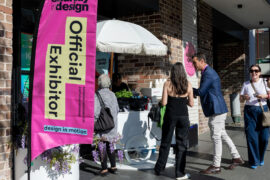Dikshu Kukreja is a man of stature. Not only is he a leader in architecture and design, he conceives projects and speaks of change that looks to a future of more thoughtful, sustainable urbanism.

December 19th, 2023
For Dikshu Kukreja, architecture is a part of his DNA and today he crafts his own architectural pathway across the globe. His father established his eponymous practice C.P. Kukreja Architects (CPKA) in 1969 in New Delhi, India, and today the multidisciplinary studio has over 200 employees across its offices in India, USA, Japan and Vietnam, as well as a portfolio of more than a thousand projects.
Kukreja studied architecture at the School of Planning and Architecture, New Delhi where he received a B. Arch Honours. He then travelled to the US to attend the Frank Lloyd Wright School of Architecture and also received a Master of Architecture and Urban Design from Harvard University. After working in France, he returned home to India and is now the Managing Principal of CPKA. With an illustrious beginning, the trajectory of Kukreja’s career has been meteoric and he is recognised globally for his work and ideas.
Yes, Kukreja is an architect of note, but he is also a master-planner, a city-maker and a visionary. He is integrally involved with placemaking, in particular strengthening architecture and design in India in a contextual and sustainable way.

“With climate change accelerating today, we need to really reassess the role of a city – whether this 20th century notion of urbanisation, which is marked by migration to cities in search of better opportunities, particularly in the global south, is a healthy phenomenon with the way that technology has progressed,” says Kukreja. “We need to dismiss this notion that only cities can be engines of growth and instead focus on creating opportunities for social and economic development for those residing in small towns and villages.
“For me, the most important aspect when one looks at master-planning is being able to create sustainable and balanced development models. And when I say that, I take that definition a little wider to even incorporating the cultural values of a place, because culture is like a precious jewel that brings a sense of identity, belonging, and meaning to a community. It’s a family heirloom that you pass on from generation to generation.”
Kukreja’s recognition of the rich history and culture of India is ever present in his design thinking and he sees that, especially now, there is an opportunity for India to take the lead incorporating its heritage into new design, learning from the past and creating architecture with social and cultural meaning. “I think places go through periods in history where they come into focus when the sun shines on them, and I think currently, India’s at a point in history where the sun is shining down on it,” he reflects.
Reflects: India’s first net-positive building

To illustrate this thinking, two projects on the drawing board at the moment at CPKA (and there are many, many more) reflect his thoughts. The first is the revitalisation of Ayodhya city, one of the most important pilgrimage sites for Hindus. As part of the consortium for the master plan, CPKA’s proposal is to make this historic Indian city a global spiritual capital and tourism hub, all the while promoting efficient land use, minimising congestion and enhancing the overall quality of life for its residents. The second project is The Brij, a museum and cultural centre for the Serendipity Arts Foundation in collaboration with CRAB Studio, that will become more of an artisan village with indoor and outdoor exhibition spaces, and performance areas with greater connection to art and people.
Thinking of urban sprawl and re-working the ideas of sustainability for residents Kukreja says, “Indian cities are growing and expanding as we speak, which presents a great opportunity for us to look at how these cities can become models of sustainable and balanced development, which is the right way forward. By that, I mean there are a lot of opportunities for Indian cities to adapt and learn from practices and solutions which have been implemented in other parts of the world. Particularly, we must learn from the accomplishments – and the mistakes – of Western cities and countries.
“For example, I am a strong proponent for public sustainable transport and I feel that the American model of private mobility centred on cars, which has been exported around the world without thought, has been extremely detrimental to not only our cities but to our planning policies and to the planet. So, I think that is one lesson we all need to learn.”

As an example of this, the practice, in collaboration on the master plan with IDOM (Spain), is currently working on India’s first Transportation-Oriented Development (TOD) project, the East Delhi Hub. This mixed-use project covers some 29.6-hectacres in New Delhi with residential, civil and commercial facilities, green spaces and transportation to become an almost self-sufficient village within this large metropolis. Extrapolating the idea of the 15-Minute City conceived by Professor Carlos Moreno of Pantheon Sorbonne University Paris, (the idea that residents can access most amenities and services within a 15-minute walk or bike ride from their home), the East Delhi Hub will make an incredible difference to the lives of people and to the landscape of the city.
A video, Tale of Two Cities with Dikshu Kukreja | Episode 3 – Melbourne & Kolkata featuring Mayor Sally Capp speaks of this. View the video here.
There is so much to say about Dikshu Kukreja. He is humble and real, eloquent and charming and as an educator there is no better. He regularly talks at conventions and conferences, has conceptualised and created two television series, is an author and has received global accolades too numerous to mention that attest to his visionary insights on architecture and sustainability. Just recently he was appointed as the Honorary Consul General for the Republic of Albania in India.
Kukreja is a man of our time and to be listened to intently. With a practice that is regularly recognised as being in the top 100 in the world and in the top five in India, his architectural actions speak for themselves. However, it is his words that inspire and resonate around the world and in every country that they are heard. This is a man who is making an indelible imprint on the architectural landscape of our time, and we need to heed his words.
CP Kukreja Architects
cpkukreja.com
Photography
Courtesy CP Kukreja Architects


We think you might also like this story on a house inspired by Chandigarh by RSDA.
INDESIGN is on instagram
Follow @indesignlive
A searchable and comprehensive guide for specifying leading products and their suppliers
Keep up to date with the latest and greatest from our industry BFF's!
The new range features slabs with warm, earthy palettes that lend a sense of organic luxury to every space.

A curated exhibition in Frederiksstaden captures the spirit of Australian design

For Aidan Mawhinney, the secret ingredient to Living Edge’s success “comes down to people, product and place.” As the brand celebrates a significant 25-year milestone, it’s that commitment to authentic, sustainable design – and the people behind it all – that continues to anchor its legacy.

Mark Tuckey X Main Studio embrace the future with a new range of furniture that showcases the beauty of agroforestry timber.

Collingwood is one of three precincts at Saturday Indesign 2025 on 6th September – find out what’s on there!
The internet never sleeps! Here's the stuff you might have missed

Dr Piers Taylor – award-winning British architect, BBC presenter and founder of Invisible Studio – returns to Australia to deliver a keynote at the inaugural Glenn Murcutt Symposium.

As French-Lebanese Architect Lina Ghotmeh prepares for lectures in Melbourne and Sydney, we hear about the philosophy shaping her internationally celebrated practice.

Karndean’s newly evolved Opus range brings versatility and durability to the forefront of commercial flooring. Blending design-led aesthetics with robust, high-performance functionality, it’s a go-to solution for spaces that demand both style and resilience.